Mitochondrial calcium uniporter stabilization preserves energetic homeostasis during Complex I impairment
- PMID: 35589699
- PMCID: PMC9120069
- DOI: 10.1038/s41467-022-30236-4
Mitochondrial calcium uniporter stabilization preserves energetic homeostasis during Complex I impairment
Erratum in
-
Author Correction: Mitochondrial calcium uniporter stabilization preserves energetic homeostasis during Complex I impairment.Nat Commun. 2022 Jun 20;13(1):3532. doi: 10.1038/s41467-022-31304-5. Nat Commun. 2022. PMID: 35725853 Free PMC article. No abstract available.
Abstract
Calcium entering mitochondria potently stimulates ATP synthesis. Increases in calcium preserve energy synthesis in cardiomyopathies caused by mitochondrial dysfunction, and occur due to enhanced activity of the mitochondrial calcium uniporter channel. The signaling mechanism that mediates this compensatory increase remains unknown. Here, we find that increases in the uniporter are due to impairment in Complex I of the electron transport chain. In normal physiology, Complex I promotes uniporter degradation via an interaction with the uniporter pore-forming subunit, a process we term Complex I-induced protein turnover. When Complex I dysfunction ensues, contact with the uniporter is inhibited, preventing degradation, and leading to a build-up in functional channels. Preventing uniporter activity leads to early demise in Complex I-deficient animals. Conversely, enhancing uniporter stability rescues survival and function in Complex I deficiency. Taken together, our data identify a fundamental pathway producing compensatory increases in calcium influx during Complex I impairment.
© 2022. The Author(s).
Conflict of interest statement
The authors declare no competing interests.
Figures
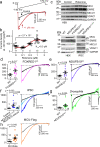
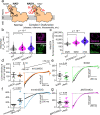

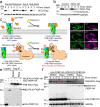
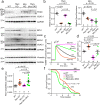
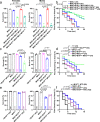

Similar articles
-
Outstanding questions regarding the permeation, selectivity, and regulation of the mitochondrial calcium uniporter.Biochem Biophys Res Commun. 2014 Jul 11;449(4):367-9. doi: 10.1016/j.bbrc.2014.04.141. Epub 2014 Apr 30. Biochem Biophys Res Commun. 2014. PMID: 24792175
-
Proteolytic control of the mitochondrial calcium uniporter complex.Proc Natl Acad Sci U S A. 2017 Apr 25;114(17):4388-4393. doi: 10.1073/pnas.1702938114. Epub 2017 Apr 10. Proc Natl Acad Sci U S A. 2017. PMID: 28396416 Free PMC article.
-
MCU encodes the pore conducting mitochondrial calcium currents.Elife. 2013 Jun 4;2:e00704. doi: 10.7554/eLife.00704. Elife. 2013. PMID: 23755363 Free PMC article.
-
[The Molecular Mechanisms of Mitochondrial Calcium Uptake by Calcium Uniporter].Yakugaku Zasshi. 2021;141(4):491-499. doi: 10.1248/yakushi.20-00204-1. Yakugaku Zasshi. 2021. PMID: 33790116 Review. Japanese.
-
The In Vivo Biology of the Mitochondrial Calcium Uniporter.Adv Exp Med Biol. 2017;982:49-63. doi: 10.1007/978-3-319-55330-6_3. Adv Exp Med Biol. 2017. PMID: 28551781 Review.
Cited by
-
Mitochondrial membrane lipids in the regulation of bioenergetic flux.Cell Metab. 2024 Sep 3;36(9):1963-1978. doi: 10.1016/j.cmet.2024.07.024. Epub 2024 Aug 22. Cell Metab. 2024. PMID: 39178855 Free PMC article. Review.
-
Monitoring mitochondrial calcium in cardiomyocytes during coverslip hypoxia using a fluorescent lifetime indicator.J Mol Cell Cardiol Plus. 2024 Jun;8:100074. doi: 10.1016/j.jmccpl.2024.100074. Epub 2024 Apr 7. J Mol Cell Cardiol Plus. 2024. PMID: 38854449 Free PMC article.
-
Inter-Organellar Ca2+ Homeostasis in Plant and Animal Systems.Cells. 2025 Aug 6;14(15):1204. doi: 10.3390/cells14151204. Cells. 2025. PMID: 40801637 Free PMC article. Review.
-
Miro1 R272Q disrupts mitochondrial calcium handling and neurotransmitter uptake in dopaminergic neurons.Front Mol Neurosci. 2022 Dec 2;15:966209. doi: 10.3389/fnmol.2022.966209. eCollection 2022. Front Mol Neurosci. 2022. PMID: 36533136 Free PMC article.
-
Mitochondrial Volume Regulation and Swelling Mechanisms in Cardiomyocytes.Antioxidants (Basel). 2023 Jul 28;12(8):1517. doi: 10.3390/antiox12081517. Antioxidants (Basel). 2023. PMID: 37627512 Free PMC article. Review.
References
-
- Territo PR, Mootha VK, French SA, Balaban RS. Ca(2+) activation of heart mitochondrial oxidative phosphorylation: role of the F(0)/F(1)-ATPase. Am. J. Physiol. Cell Physiol. 2000;278:C423–C435. - PubMed
-
- Aydin J, et al. Increased mitochondrial Ca2+ and decreased sarcoplasmic reticulum Ca2+ in mitochondrial myopathy. Hum. Mol. Genet. 2009;18:278–288. - PubMed
Publication types
MeSH terms
Substances
Grants and funding
LinkOut - more resources
Full Text Sources
Molecular Biology Databases
Research Materials

